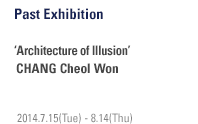
- GALLERY
- CURRENT
- UPCOMING
- PAST
- Half side/Other side
- EIN STEIN Thinking about Thinking
- Fiminism Fnositicism
- Portrait the Nature:Stars and Flowers
- white-hole diary
- ART369
- ABSINTHE1
- Completion in Incompletion
- Full of Emptiness
- Luminizing Sequence 2: Into the Maze of Momentum
- Characterless Characters
- Architecture of Illusion
- Whispering of Layers
- Small is Beautiful
- Urban Park
- Construction & De-Construction
- Serious Joke
- Retrospective
- 위대한 설계
- Fearless Creation
- Some Watchtower
- Fantasy Factor
- 적극가담자-방관자
- Root of Imagination
- SIGMA COMPLEX
- K's Room
- SUM IN A POINT OF TIME
- Memories
- Ordinary People
- Root of Imagination
- 幻 Solid Illusion
- 화해: Reconciled
- ARTISTS
- CHA Seung Ean
- CHANG Cheol Won
- CHOI Won Jung
- CHOI Wool Ga
- HAN Jin Su
- HAN Won Suk
- HONG Buhm
- HONG Zi
- KIM Ha Young
- KIM Ji Eun
- KIM Ki Ra
- KIM Si Nae
- KIM Young Bae
- LEEFI
- LEE Seung Min
- LEE Su Jin
- LEE Yeon Sook
- LEE Yong Baek
- PAE Sung Hee
- PARK Cheon Wook
- PARK Jung Hyuk
- PARK Mun Hee
- PARK Sang Ho
- PARK Seung Mo
- PARK Seung Yea
- PARK Sung Yeon
- RYU Jung Min
- RYU SungHun
- SEO Min Jeong
- SIM Seung Wook
- YOON Byung Woon
- NEWS
- TOMORROW+





















장철원 작업이 구축하는 “분리/공유”의 프랙탈 공간
신진 작가로서 첫 번째 개인전을 갖는 장철원은 ‘자연이 만들어내는 질서’에 관심을 갖고, 그것을 예술적으로 표현해내는 작업들을 선보이고 있다. 작가가 스스로 붙인 “Architecture of Illusion(환영의 건축)”이란 전시 제목이 드러내듯이, 이번에 보여주는 작업들은 그 질서들을 이루는 규칙과 구조에 대한 관심을 평면에 구축한 것들이다. 그리고 이러한 작업은 비규칙적 요소들과 산발적 사건들을 통해 구성되는 실재계의 혼돈에 내재한 질서 구조이자 그것을 묘사 가능케 하는 프랙탈 구조의 공간이라고 부를 수 있을 것이다. 장철원 작가는 처음부터 자연 속에 존재하는 혹은 자연을 이루는 비례와 질서 등을 현실 속에서 재구축하는 데 관심을 기울이면서 설치 작업을 시도하기도 했었다. 그러나 첫 번째 개인전인 이번 전시에서는 그 질서들을 관찰해서 포착하고 더욱 정교하게 작품 속에서 드러내기 위해 그동안 집중하고 다져온 평면에서의 조형적 단계들을 보여주고 있다. 이 작품들의 의미는 화면 속에서 구성된 선들의 조합과 형태 자체라기보다는, 그것들을 통해 자연 속에 존재하는 질서와 체계의 단계들을 자신이 파악한 대로 하나씩 구축하는 과정들과의 유사 단계로 드러낸다는 것에 있다. 그리고 이것은 <Macro & Micro>라는 제목이 보여주듯, 미시적인 것의 중첩이 또 하나의 거시를 구성함과 동시에 거시적인 것은 미시적인 것으로 분해될 수 있다는 의미이기도 하다.
<하나, 그리고 네 개의 오렌지>는 조셉 코수스의 <하나, 그리고 세 개의 의자>라는 작업의 제목을 전용하여 붙인 작품인데, 일련의 다른 작품들을 이해하는 데 출발점이 되고 있다. 장철원은 오렌지라는 하나의 자연물의 모든 알맹이가 유사한 형태를 지니지만 제각각 다른 크기와 방향을 가지고 있다는 점을 먼저 관찰하고, 이내 그렇게 서로의 독자성이 한 가운데를 향해 수렴되는 규칙 안에 존재하고 있다는 점을 발견한다. 작가는 먼저 실제 오렌지의 단면을 c-print로 출력하고 그것을 단순화시킨 몇 안 되는 선들의 중첩을 통한 구조를 그래픽 도형으로 만들어서 이 역시 c-print로 출력했다. 그리고 이 다음 단계가 바로 장철원의 ‘예술’ 작업이 되는데, 컴퓨터로 정밀하게 제작된 형태를 수작업을 통해 ‘동일하게’ 묘사된 드로잉 작업과 색연필로 ‘재현된’ 작품들이 모여 하나의 단일 작업을 구성하고 있다. 그의 여타 작업들은 거의가 단순한 선들이 중첩되어 복잡한 구조를 이루는 드로잉 작품들이며, 연필, 잉크, 파스텔과 같이 다양한 재료를 통해 프랙탈 구조 속에 담길 수 있는 새로운 공간들을 형성시킨다. 장철원 작가가 재구성한 형태와 그 사이 공간들은 각기 상이한 요소들 간의 분리/공유(분유)의 공간이 되며, 이것은 아마도 낭시(Jean-Luc Nancy)가 말하는 ‘단수이자 복수로서의 존재’가 “분유”하고 있음을 시각적으로 구축한 것으로 이해될 수 있을 것이다. 인류는 고대부터 자연 속의 비례를 찾기 위해 노력하며 황금율을 발견해서 건축과 예술에 적용했고, 이것은 자연과 기하학이 대립되는 이분법적 구조가 아니라 자연 속에 기하학이 존재하고 기하학 속에서 자연을 찾을 수 있다는 것을 의미하기 때문이다. 그래서 장철원은 원(圓) 구조를 구성할 때도 √2 (1:1.414)의 비례를 갖추고 있는 A4 사이즈의 종이를 이용함으로써, 서로 어긋난 듯이 보이는 구성 속에 비례의 공간이 존재하도록 한다. 이것은 그가 관찰하고 발견하고 재구축한 프랙탈 구조가, 실재적이고 디지털적이고 회화적인 다양한 공간으로의 변환이 가능하다는 점을 보여준다.
그런데 장철원 작가가 의도하는 바 혹은 예술적 목적이 이것이라면 그는 왜 굳이 편리한 디지털 매체를 이용하지 않고 시간이 더 걸리고 수고로운 전통적 수작업의 과정을 통해 작품을 제작하는 것일까? 그것은 그가 프랙탈 구조를 예술로 표현하는 이 작업의 시리즈를 회화의 영역에서 완결하려는 것이 아니라, 평면의 공간으로부터 현실의 실제 공간으로 확장된 질서의 탐구로 이어가고자 하는 의도가 담겨 있기 때문이다. 현실과 자연은 무수한 우발적 변수들에 의해 구성돼 있으며, 이들 중 어떤 것들은 통제되지 못한 채 남아 있기도 하고 어떤 것들은 통제되거나 통제되고 있다는 판타지 속에 머물기도 한다. 그러면서도 그것들은 그 자체로 고유의 질서와 체계를 유지하고 있다. 그래서 작가는 디지털 픽셀들의 구성이 갖는 물성의 한계를 극복하고 자신이 전공으로 삼았던 회화적 예술성을 담아내기 위해 번거로운 수작업을 병행한다. 작가 자신이 이 과정에서 마치 만다라와 같이 필연적인 수행성을 경험하게 되고, 관람자 역시 최종 결과물로서의 이미지 관조가 아닌 숭고의 체험을 의도하고 있다. 그는 이를 위해 두께가 거의 항상 동일한 샤프연필 대신, 직접 깎은 연필을 사용하며 모든 선이 서로 다른 두께를 지니도록 했다. 하나의 선 안에서조차 각 부분마다 굵기가 달라지는 모든 선들은 자기 자신과도 달라지며 “선”이라는 한 단어의 개념 아래 묶이지 못한다. 그럼에도 그 선들은 모두 중심을 향하는 방향성을 획득하고, 서로 반복적인 중첩을 통해 구성하는 형태는 또 하나의 구조와 공간을 발생시킨다. 각 선들이 갖는 방향성과 이질성의 총합은 기하학적 요소들이 결국 유기적인 것이라는 프랙탈 구조를 완성시키게 되는 것이다. 알고리즘의 단순성을 반복하며 갖는 차원분열 구조로서의 프랙탈 구조는 그 순환성과 자기유사성을 통해 ‘분리’와 ‘공유’가 동시에 발생되게 한다. <Flash> 시리즈에서 검은 아크릴 바탕 위에 가느다란 색선(色線)을 통해 암시된 실제 공간에서의 구조화가 장철원의 작업에서 앞으로 어떻게 진행되고 구현될지 지켜볼 일이다. 또한 이것이 현실을 외면하고 벗어나지 않으며, 혼란스럽게 보이는 현상을 설명하는 새로운 언어로서 어떻게 적절한 예술적 거리감을 유지할지 궁금하게 만드는 긴장의 요소라고 생각된다.
장원 (미술평론가)
The Fractal Space of "Separation/Sharing" constructed in Cheolwon Chang's Works
Cheolwon Chang, an emerging artist who opens his first solo exhibition, has been interested in the 'order created in the nature' and shows works that transfigure it in artistic ways. As the artist entitled "Architecture of Illusion," his works consist of what are constructed with his interests in the rules and structures building that order. We thus might be able to call his works as a fractal space in which the real order of chaos is composed with irregular events and sporadic factors inherent but describable. The artist once tried an installation works, paying attention, from the outset, to the reconstruction of the proportion and order that conform nature or house within nature in reality. Chang's first solo exhibition shows, however, the artistic stages on the two dimensional works that he has focused on in order that he could observe the order more elaborately and strengthen it in his art. The significance of his recent works does not lie on the visible result of the combination or the figures of the lines used in the pieces but on the fact that this exhibition makes spectators experience an analogy between the constructing stages of his art and those of the order and systematic structures inherent in nature. And it also means, as the title of a series Macro & Micro exposes, that the piling of micro composes macro and, in reverse, macro can be decomposed into micros.
Cheolwon Chang's One and Four Oranges, appropriating the title of Joseph Kosuth's One and Three Chairs, is a staring point to comprehend his other works. By observing at first that an orange as a natural object has granules that look similar but each has different size and is disparately oriented, the artist comes to discover a regulation that all are convergent to its center. Before making his own art, he first printed out the image of the orange's sliced section with c-print as well as its structure with a few simplified lines through their reiteration. The very next step composes Chang's 'art' works, which consist of a single piece constructed by 'identically' described drawing works and 'represented' with color crayons through his own handworks from minutely handled by computer work. His other works are mainly drawing pieces that pile up a complex structure with simple but repetitive lines, and create new spaces which can be contained in a fractal structure with diverse materials like pencil, ink, pastel and so on. The reconstructed forms and their in-between spaces by the artist become such spaces as 'separation/sharing' among disparate factors, and this might be understood as the visual embodiment of 'being as singular and multiple' what Jean-Luc Nancy says. It is because humans have struggled from ancient time so as to find the proportions inherent within nature and discovered gold ratio to apply it to architecture and art, meaning that nature and geometry do not dwell in dichotomous structure but geometry houses in nature and vice versa. Therefore, Cheolwon Chang uses A4 size paper of √2 (1:1.414) proportion even when he puts a circular structure, intending the creation of proportional spaces with a structure that looks out of joint. This exposes us a fact that the fractal structure observed, discovered, and reconstructed by the artist can transit into such diverse spaces as actual, digital, and pictorial.
But why does Cheolwon Chang produces his works obstinately through time consuming and toilsome process of traditional handwork instead of more convenient digital media if his artistic intention is as such? It is because his final goal in this art series is the expansion of his investigation of order into the actual space in reality. He does not want to complete his works with paintings and drawings but pursues to broaden them into real world. As a matter of fact, the reality and the nature are composed with numerous accidental variables; some remain out of regulation, whilst others are ruled even though in a fantasy that human rules them. Simultaneously, they keep their own order and system of themselves. The artist practices therefore the cumbersome handworks in order to overcome the limitation of materiality in using digital pixels and to contain his artistic properties as a painter. In this process, the artist himself happens to experience a sort of inevitable performativity as in 'madala(Buddhist picture),' and aims that his viewers also can experience of sublime instead of appreciating his art as an image object. For this, not using a sharp-pencil of which thickness is mostly stable, Chang intended a variability of the thickness of every line by using plane pencils. Each line in which its thicknesses vary even part by part, differs itself from other lines, so cannot be tied under a single concept of "line." Nevertheless, all these lines acquire an orientation toward a center of a larger circular chape and generate another structure and space by a main form composed through their reiterations. Then, the totality of orientation and heterogeneity in each line comes to perfection of a fractal structure in which geometric elements are eventually organic. The fractal structure, as the construction of dimension-splitting structure obtained by repeating the simplicity of algorithm, makes 'separation' and 'sharing' happen at the same time, through its own circularity and self-similarity. It must be interesting to observe how this artist steps further toward the embodiment of structuring his works in actual spaces implied with thin color lines in his Flash series. In addition, it is conceived as a factor of tension in his art that his future works, as a new vocabulary of art, make us curious how they avoid escaping or derailing the reality but keep an adequate, artistic distance to explain chaotic phenomenon.
Chang, Won (art critic)
